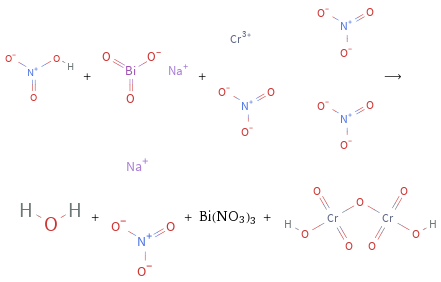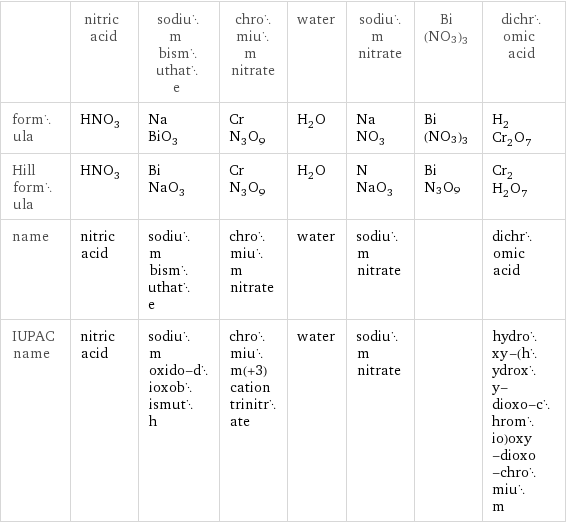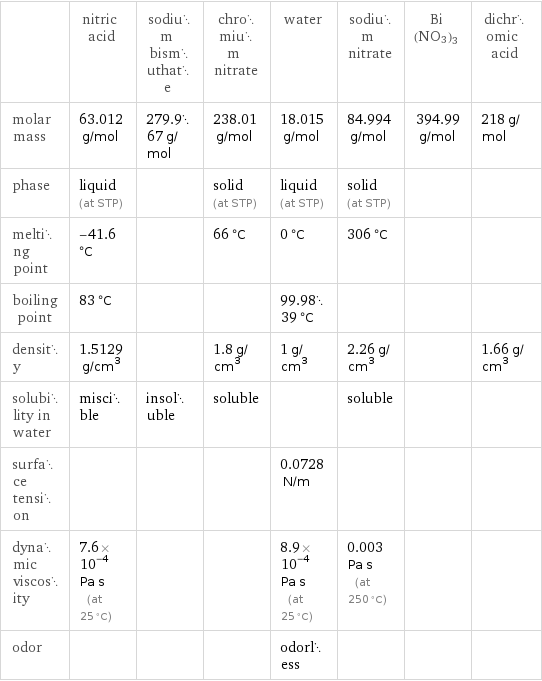Input interpretation

HNO_3 nitric acid + NaBiO_3 sodium bismuthate + CrN_3O_9 chromium nitrate ⟶ H_2O water + NaNO_3 sodium nitrate + Bi(NO3)3 + H_2Cr_2O_7 dichromic acid
Balanced equation

Balance the chemical equation algebraically: HNO_3 + NaBiO_3 + CrN_3O_9 ⟶ H_2O + NaNO_3 + Bi(NO3)3 + H_2Cr_2O_7 Add stoichiometric coefficients, c_i, to the reactants and products: c_1 HNO_3 + c_2 NaBiO_3 + c_3 CrN_3O_9 ⟶ c_4 H_2O + c_5 NaNO_3 + c_6 Bi(NO3)3 + c_7 H_2Cr_2O_7 Set the number of atoms in the reactants equal to the number of atoms in the products for H, N, O, Bi, Na and Cr: H: | c_1 = 2 c_4 + 2 c_7 N: | c_1 + 3 c_3 = c_5 + 3 c_6 O: | 3 c_1 + 3 c_2 + 9 c_3 = c_4 + 3 c_5 + 9 c_6 + 7 c_7 Bi: | c_2 = c_6 Na: | c_2 = c_5 Cr: | c_3 = 2 c_7 Since the coefficients are relative quantities and underdetermined, choose a coefficient to set arbitrarily. To keep the coefficients small, the arbitrary value is ordinarily one. For instance, set c_7 = 1 and solve the system of equations for the remaining coefficients: c_1 = 6 c_2 = 3 c_3 = 2 c_4 = 2 c_5 = 3 c_6 = 3 c_7 = 1 Substitute the coefficients into the chemical reaction to obtain the balanced equation: Answer: | | 6 HNO_3 + 3 NaBiO_3 + 2 CrN_3O_9 ⟶ 2 H_2O + 3 NaNO_3 + 3 Bi(NO3)3 + H_2Cr_2O_7
Structures

+ + ⟶ + + Bi(NO3)3 +
Names

nitric acid + sodium bismuthate + chromium nitrate ⟶ water + sodium nitrate + Bi(NO3)3 + dichromic acid
Equilibrium constant
![Construct the equilibrium constant, K, expression for: HNO_3 + NaBiO_3 + CrN_3O_9 ⟶ H_2O + NaNO_3 + Bi(NO3)3 + H_2Cr_2O_7 Plan: • Balance the chemical equation. • Determine the stoichiometric numbers. • Assemble the activity expression for each chemical species. • Use the activity expressions to build the equilibrium constant expression. Write the balanced chemical equation: 6 HNO_3 + 3 NaBiO_3 + 2 CrN_3O_9 ⟶ 2 H_2O + 3 NaNO_3 + 3 Bi(NO3)3 + H_2Cr_2O_7 Assign stoichiometric numbers, ν_i, using the stoichiometric coefficients, c_i, from the balanced chemical equation in the following manner: ν_i = -c_i for reactants and ν_i = c_i for products: chemical species | c_i | ν_i HNO_3 | 6 | -6 NaBiO_3 | 3 | -3 CrN_3O_9 | 2 | -2 H_2O | 2 | 2 NaNO_3 | 3 | 3 Bi(NO3)3 | 3 | 3 H_2Cr_2O_7 | 1 | 1 Assemble the activity expressions accounting for the state of matter and ν_i: chemical species | c_i | ν_i | activity expression HNO_3 | 6 | -6 | ([HNO3])^(-6) NaBiO_3 | 3 | -3 | ([NaBiO3])^(-3) CrN_3O_9 | 2 | -2 | ([CrN3O9])^(-2) H_2O | 2 | 2 | ([H2O])^2 NaNO_3 | 3 | 3 | ([NaNO3])^3 Bi(NO3)3 | 3 | 3 | ([Bi(NO3)3])^3 H_2Cr_2O_7 | 1 | 1 | [H2Cr2O7] The equilibrium constant symbol in the concentration basis is: K_c Mulitply the activity expressions to arrive at the K_c expression: Answer: | | K_c = ([HNO3])^(-6) ([NaBiO3])^(-3) ([CrN3O9])^(-2) ([H2O])^2 ([NaNO3])^3 ([Bi(NO3)3])^3 [H2Cr2O7] = (([H2O])^2 ([NaNO3])^3 ([Bi(NO3)3])^3 [H2Cr2O7])/(([HNO3])^6 ([NaBiO3])^3 ([CrN3O9])^2)](../image_source/a8445d54858edda8f293a8b55ca1e7de.png)
Construct the equilibrium constant, K, expression for: HNO_3 + NaBiO_3 + CrN_3O_9 ⟶ H_2O + NaNO_3 + Bi(NO3)3 + H_2Cr_2O_7 Plan: • Balance the chemical equation. • Determine the stoichiometric numbers. • Assemble the activity expression for each chemical species. • Use the activity expressions to build the equilibrium constant expression. Write the balanced chemical equation: 6 HNO_3 + 3 NaBiO_3 + 2 CrN_3O_9 ⟶ 2 H_2O + 3 NaNO_3 + 3 Bi(NO3)3 + H_2Cr_2O_7 Assign stoichiometric numbers, ν_i, using the stoichiometric coefficients, c_i, from the balanced chemical equation in the following manner: ν_i = -c_i for reactants and ν_i = c_i for products: chemical species | c_i | ν_i HNO_3 | 6 | -6 NaBiO_3 | 3 | -3 CrN_3O_9 | 2 | -2 H_2O | 2 | 2 NaNO_3 | 3 | 3 Bi(NO3)3 | 3 | 3 H_2Cr_2O_7 | 1 | 1 Assemble the activity expressions accounting for the state of matter and ν_i: chemical species | c_i | ν_i | activity expression HNO_3 | 6 | -6 | ([HNO3])^(-6) NaBiO_3 | 3 | -3 | ([NaBiO3])^(-3) CrN_3O_9 | 2 | -2 | ([CrN3O9])^(-2) H_2O | 2 | 2 | ([H2O])^2 NaNO_3 | 3 | 3 | ([NaNO3])^3 Bi(NO3)3 | 3 | 3 | ([Bi(NO3)3])^3 H_2Cr_2O_7 | 1 | 1 | [H2Cr2O7] The equilibrium constant symbol in the concentration basis is: K_c Mulitply the activity expressions to arrive at the K_c expression: Answer: | | K_c = ([HNO3])^(-6) ([NaBiO3])^(-3) ([CrN3O9])^(-2) ([H2O])^2 ([NaNO3])^3 ([Bi(NO3)3])^3 [H2Cr2O7] = (([H2O])^2 ([NaNO3])^3 ([Bi(NO3)3])^3 [H2Cr2O7])/(([HNO3])^6 ([NaBiO3])^3 ([CrN3O9])^2)
Rate of reaction
![Construct the rate of reaction expression for: HNO_3 + NaBiO_3 + CrN_3O_9 ⟶ H_2O + NaNO_3 + Bi(NO3)3 + H_2Cr_2O_7 Plan: • Balance the chemical equation. • Determine the stoichiometric numbers. • Assemble the rate term for each chemical species. • Write the rate of reaction expression. Write the balanced chemical equation: 6 HNO_3 + 3 NaBiO_3 + 2 CrN_3O_9 ⟶ 2 H_2O + 3 NaNO_3 + 3 Bi(NO3)3 + H_2Cr_2O_7 Assign stoichiometric numbers, ν_i, using the stoichiometric coefficients, c_i, from the balanced chemical equation in the following manner: ν_i = -c_i for reactants and ν_i = c_i for products: chemical species | c_i | ν_i HNO_3 | 6 | -6 NaBiO_3 | 3 | -3 CrN_3O_9 | 2 | -2 H_2O | 2 | 2 NaNO_3 | 3 | 3 Bi(NO3)3 | 3 | 3 H_2Cr_2O_7 | 1 | 1 The rate term for each chemical species, B_i, is 1/ν_i(Δ[B_i])/(Δt) where [B_i] is the amount concentration and t is time: chemical species | c_i | ν_i | rate term HNO_3 | 6 | -6 | -1/6 (Δ[HNO3])/(Δt) NaBiO_3 | 3 | -3 | -1/3 (Δ[NaBiO3])/(Δt) CrN_3O_9 | 2 | -2 | -1/2 (Δ[CrN3O9])/(Δt) H_2O | 2 | 2 | 1/2 (Δ[H2O])/(Δt) NaNO_3 | 3 | 3 | 1/3 (Δ[NaNO3])/(Δt) Bi(NO3)3 | 3 | 3 | 1/3 (Δ[Bi(NO3)3])/(Δt) H_2Cr_2O_7 | 1 | 1 | (Δ[H2Cr2O7])/(Δt) (for infinitesimal rate of change, replace Δ with d) Set the rate terms equal to each other to arrive at the rate expression: Answer: | | rate = -1/6 (Δ[HNO3])/(Δt) = -1/3 (Δ[NaBiO3])/(Δt) = -1/2 (Δ[CrN3O9])/(Δt) = 1/2 (Δ[H2O])/(Δt) = 1/3 (Δ[NaNO3])/(Δt) = 1/3 (Δ[Bi(NO3)3])/(Δt) = (Δ[H2Cr2O7])/(Δt) (assuming constant volume and no accumulation of intermediates or side products)](../image_source/b6a947daebd2c4f2a147017addf4af6a.png)
Construct the rate of reaction expression for: HNO_3 + NaBiO_3 + CrN_3O_9 ⟶ H_2O + NaNO_3 + Bi(NO3)3 + H_2Cr_2O_7 Plan: • Balance the chemical equation. • Determine the stoichiometric numbers. • Assemble the rate term for each chemical species. • Write the rate of reaction expression. Write the balanced chemical equation: 6 HNO_3 + 3 NaBiO_3 + 2 CrN_3O_9 ⟶ 2 H_2O + 3 NaNO_3 + 3 Bi(NO3)3 + H_2Cr_2O_7 Assign stoichiometric numbers, ν_i, using the stoichiometric coefficients, c_i, from the balanced chemical equation in the following manner: ν_i = -c_i for reactants and ν_i = c_i for products: chemical species | c_i | ν_i HNO_3 | 6 | -6 NaBiO_3 | 3 | -3 CrN_3O_9 | 2 | -2 H_2O | 2 | 2 NaNO_3 | 3 | 3 Bi(NO3)3 | 3 | 3 H_2Cr_2O_7 | 1 | 1 The rate term for each chemical species, B_i, is 1/ν_i(Δ[B_i])/(Δt) where [B_i] is the amount concentration and t is time: chemical species | c_i | ν_i | rate term HNO_3 | 6 | -6 | -1/6 (Δ[HNO3])/(Δt) NaBiO_3 | 3 | -3 | -1/3 (Δ[NaBiO3])/(Δt) CrN_3O_9 | 2 | -2 | -1/2 (Δ[CrN3O9])/(Δt) H_2O | 2 | 2 | 1/2 (Δ[H2O])/(Δt) NaNO_3 | 3 | 3 | 1/3 (Δ[NaNO3])/(Δt) Bi(NO3)3 | 3 | 3 | 1/3 (Δ[Bi(NO3)3])/(Δt) H_2Cr_2O_7 | 1 | 1 | (Δ[H2Cr2O7])/(Δt) (for infinitesimal rate of change, replace Δ with d) Set the rate terms equal to each other to arrive at the rate expression: Answer: | | rate = -1/6 (Δ[HNO3])/(Δt) = -1/3 (Δ[NaBiO3])/(Δt) = -1/2 (Δ[CrN3O9])/(Δt) = 1/2 (Δ[H2O])/(Δt) = 1/3 (Δ[NaNO3])/(Δt) = 1/3 (Δ[Bi(NO3)3])/(Δt) = (Δ[H2Cr2O7])/(Δt) (assuming constant volume and no accumulation of intermediates or side products)
Chemical names and formulas

| nitric acid | sodium bismuthate | chromium nitrate | water | sodium nitrate | Bi(NO3)3 | dichromic acid formula | HNO_3 | NaBiO_3 | CrN_3O_9 | H_2O | NaNO_3 | Bi(NO3)3 | H_2Cr_2O_7 Hill formula | HNO_3 | BiNaO_3 | CrN_3O_9 | H_2O | NNaO_3 | BiN3O9 | Cr_2H_2O_7 name | nitric acid | sodium bismuthate | chromium nitrate | water | sodium nitrate | | dichromic acid IUPAC name | nitric acid | sodium oxido-dioxobismuth | chromium(+3) cation trinitrate | water | sodium nitrate | | hydroxy-(hydroxy-dioxo-chromio)oxy-dioxo-chromium
Substance properties

| nitric acid | sodium bismuthate | chromium nitrate | water | sodium nitrate | Bi(NO3)3 | dichromic acid molar mass | 63.012 g/mol | 279.967 g/mol | 238.01 g/mol | 18.015 g/mol | 84.994 g/mol | 394.99 g/mol | 218 g/mol phase | liquid (at STP) | | solid (at STP) | liquid (at STP) | solid (at STP) | | melting point | -41.6 °C | | 66 °C | 0 °C | 306 °C | | boiling point | 83 °C | | | 99.9839 °C | | | density | 1.5129 g/cm^3 | | 1.8 g/cm^3 | 1 g/cm^3 | 2.26 g/cm^3 | | 1.66 g/cm^3 solubility in water | miscible | insoluble | soluble | | soluble | | surface tension | | | | 0.0728 N/m | | | dynamic viscosity | 7.6×10^-4 Pa s (at 25 °C) | | | 8.9×10^-4 Pa s (at 25 °C) | 0.003 Pa s (at 250 °C) | | odor | | | | odorless | | |
Units
